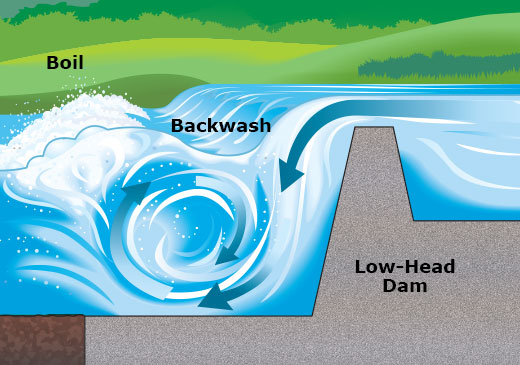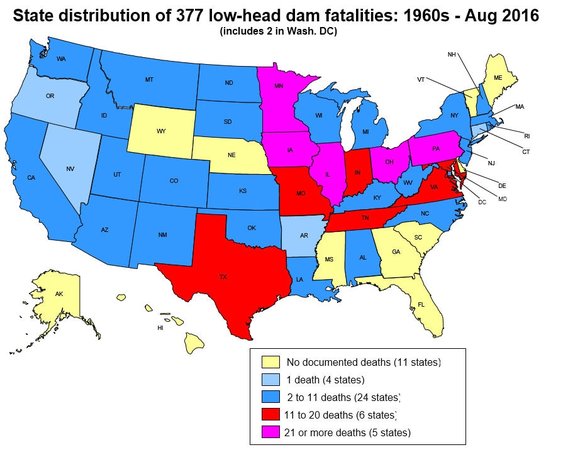A low-head head dam is a structure that generally spans from one side of a riverbank to the other, partially blocking the waterway and creating a back-up of water behind the dam. As water reaches the wall, it flows over the drop off, which can be anywhere from 6 inches to 25 feet. Low-head dams can be found in rivers and streams across the country. Tens of thousands of them were built in the 1800s to power gristmills and small industries. While there are some modern uses for these dams (including raising the water level for improving municipal and industrial water supplies, producing hydropower, and diverting irrigation water), they have outlived their usefulness.

Why are low-head dams dangerous?
Low head dams are referred to as “drowning machines” because the water movement you create is a lot like what you might find in a washing machine – the current can push people under water and spin them around, making it almost impossible to escape.
- Low-head dams are difficult to spot from upstream and often are not marked by signs or buoys.
- Generally, both sides of a dam consist of a vertical concrete abutment that can be difficult to scale if the victim manages to reach it.
- Fallen tree branches and other debris can be trapped in the hydraulic along with the victim creating trauma hazards.
- In the months between fall and spring, the water temperature can be extremely cold, which can significantly decrease the victim’s survival time.
- Air bubbles mix into the water, decreasing the buoyancy by one-third, which makes staying afloat even more difficult (even with a life jacket).
These factors, along with the powerful recirculating hydraulics can trap and drown unsuspecting river users.

How many fatalities have been caused by low-head dams in the US?
Dr. Bruce Tschantz, P.E., Ph.D. of the University of Tennessee has documented for the period of 1960 to August 2016, 304 incidents with low-head dams that resulted in 377 fatalities and 103 injuries. Fatalities occurred in 94% of the incidents. The map below shows the distribution of low-head dam fatalities by state. As of August 2016, 39 states have had at least one death. Forty-six percent of the fatalities have occurred in Iowa, Illinois, Minnesota, Ohio and Pennsylvania (magenta-shaded states). An additional 24 percent of the fatalities have occurred in Indiana, Maryland, Missouri, Tennessee, Texas and Virginia (red-shaded states).

If you or a loved one has been hurt by a low-head dam, the Hannon Law Firm has experience that can help.
If you or a loved one has been hurt by a low-head dam, an experienced attorney can help you navigate the legal system and seek justice.
At The Hannon Law Firm, LLC, we have 22 years of experience Seeking Justice with Compassion (SM). Our legal team is sensitive to the needs of individuals with personal injuries and knows how traumatic injuries can impact your entire family.
You can call our office at 303-861-8800 or contact us through the form below.
Other resources:
- Low Head Dams: What are they? by Bruce A. Tschantz, P.E.
- Association of State Dam Safety
- What we know (and don’t know) about low-head dams by Bruce Tschantz
- Locations of fatalities at submerged hydraulic jumps
- The Federal Energy Regulatory Commission: Safety Signage at Hydropower Projects
- USA Today: Picturesque low dams turn deadly with swift currents
- Suggested low-head dam references and information
